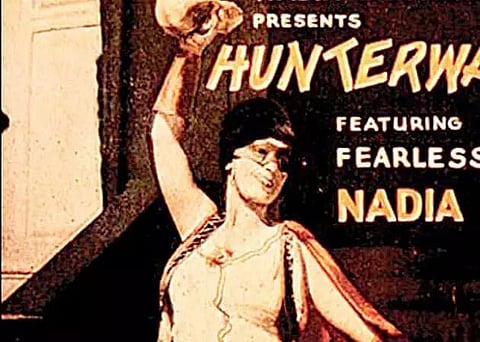
- Home
- Live Blog
- Breaking News
- Top Headlines
- Cities
- NE News
- Sentinel Media
- Sports
- Education
- Jobs

Who doesn’t love a film filled with action, drama, and jaw-dropping fight sequences? Indian cinema has always been home to spectacular stunt-filled films that keep audiences at the edge of their seats. However, behind the breathtaking action scenes, there exist the unsung heroes of the industry—stunt performers. These brave individuals risk their lives to create the most thrilling cinematic moments, yet they often remain unrecognized.
In the early years of Indian cinema, female characters were typically played by men, and female stunt performers were almost unheard of. However, there was one woman who broke all barriers and redefined the role of women in action films—Fearless Nadia.
Born as Mary Ann Evans on January 8, 1908, in Perth, Australia, Fearless Nadia was destined for greatness. Her father, a British soldier, was stationed in India, where she spent much of her early life. After the tragic loss of her father during World War I in 1915, she moved with her mother to Peshawar (now in Pakistan). It was here that she developed her adventurous spirit, learning skills like horseback riding, hunting, fishing, and shooting—all of which would later prove invaluable in her film career.
Nadia eventually moved to Bombay (now Mumbai) and began studying ballet under Madam Astrova, which further honed her flexibility and physical prowess. Initially, she worked as a salesgirl in the Army & Navy Store but had bigger aspirations. She joined a traveling troupe where she performed in front of British soldiers, at royal palaces, and even in small Indian villages. This phase of her life exposed her to acrobatics, including cartwheels and splits, which would become a signature in her future films.
Nadia’s entry into the world of cinema was pure destiny. While performing with Zako Circus, she caught the attention of J.B.H. Wadia, the founder of Wadia Movietone, a production house that specialized in stunt and action films in the 1930s. Although initially skeptical about casting a blonde, blue-eyed woman in an Indian film, Wadia decided to give her a chance.
Her first break came as a cameo role as a slave girl in the film Desh Deepak. However, it was her role as Princess Parizaad in Noor-e-Yaman that truly got her noticed. Seeing her immense potential, Wadia’s younger brother Homi Wadia took charge of shaping her career.
In 1935, Nadia starred in the Hindi action film Hunterwali, which became a massive success and catapulted her to stardom. In the film, she played a masked vigilante who fought against injustice using her signature whip.
What made Hunterwali legendary was not just its action-packed storyline but also the fact that Nadia performed her own stunts—a rarity for women at the time. Whether it was lifting a man over her head, performing acrobatics, or engaging in high-speed chases on horseback, she did it all. The film’s most iconic dialogue, “Aaj se main Hunterwali hoon” (From today, I am the woman with the whip), became a symbol of female empowerment.
The film was such a hit that it solidified Fearless Nadia as a cultural icon. Other filmmakers soon started casting her in similar roles, making her the most popular stunt actress of her time.
Nadia continued to push boundaries with her fearless performances. In the film Jungle Princess (1942), she performed dangerous stunts with real lions. She later recalled in a 1989 BBC interview how she was trained to look directly into the lion’s eyes without blinking, an act that helped her gain their trust. She even went as far as pulling their tails and sitting on them during her stunts.
Nadia’s ability to challenge the typical “damsel in distress” trope made her a feminist icon. While most female characters in 1940s Indian cinema were depicted as helpless, she stood out as a strong, independent, and fearless woman. She became the face of female empowerment, proving that women could be just as daring as men.
Even after her retirement, Nadia’s impact on Indian cinema remained strong. Her great-grandnephew, Riyad Vinci Wadia, created a documentary in 1993 titled Fearless: The Hunterwali Story, chronicling her life and contributions to Indian cinema.
Her influence extended beyond documentaries—her legacy inspired Bollywood filmmakers as well. In the 2017 film Rangoon, directed by Vishal Bhardwaj, actress Kangana Ranaut’s character was based on Fearless Nadia. The film attempted to capture the spirit and essence of the legendary stunt queen.
Nadia passed away on January 9, 1996, but her bold, fearless attitude continues to inspire generations. She was not just a stunt performer; she was a symbol of power, elegance, and sheer determination. Her story remains a testament to the fact that courage and talent know no gender.
Fearless Nadia was much more than an actress; she was a revolution in Indian cinema. She shattered gender norms, redefined action cinema, and paved the way for future generations of female stunt performers. Her name will forever be etched in history as India’s original stunt queen—an icon of bravery, skill, and resilience.
Even today, her story serves as an inspiration to women across the world, reminding them to be bold, fearless, and unapologetically themselves.
Also Read: Heaven, Wait --- Hauntingly Beautiful
Also Watch: